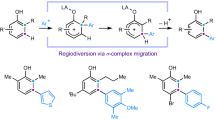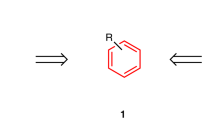Abstract
IT is a commonplace that those acid-catalysed aromatic rearrangements, which conform to the general pattern,  notwithstanding that they are formally so similar, do not all proceed by the same mechanism: some involve intermolecular processes and some intramolecular. But they are usually all held to have at least this in common, namely, that X migrates as an electrophilic fragment: whatever adventures it may go through while in transit, it separates from nitrogen without the electrons by which it was bound thereto, and it unites with aromatic carbon by means of electrons which the latter has to supply. Such rearrangements may be called ‘electrophilic rearrangements’.
notwithstanding that they are formally so similar, do not all proceed by the same mechanism: some involve intermolecular processes and some intramolecular. But they are usually all held to have at least this in common, namely, that X migrates as an electrophilic fragment: whatever adventures it may go through while in transit, it separates from nitrogen without the electrons by which it was bound thereto, and it unites with aromatic carbon by means of electrons which the latter has to supply. Such rearrangements may be called ‘electrophilic rearrangements’.
This is a preview of subscription content, access via your institution
Access options
Subscribe to this journal
Receive 51 print issues and online access
$199.00 per year
only $3.90 per issue
Buy this article
- Purchase on Springer Link
- Instant access to full article PDF
Prices may be subject to local taxes which are calculated during checkout
Similar content being viewed by others
References
Dewar, ‘Electronic Theory of Organic Reactions’, 225 (Oxford Univ. Press, 1949).
Ingold, Smith and Vass, J. Chem. Soc., 1245 (1927).
Bamberger, many papers since 1894, including three summarizing papers: Annalen, 424, 233, 297 (1921); 441, 207 (1925).
Author information
Authors and Affiliations
Rights and permissions
About this article
Cite this article
HELLER, H., HUGHES, E. & INGOLD, C. A New View of the Arylhydroxylamine Rearrangement. Nature 168, 909–910 (1951). https://doi.org/10.1038/168909a0
Issue Date:
DOI: https://doi.org/10.1038/168909a0
This article is cited by
-
A New View of the Arylhydroxylamine Rearrangement
Nature (1952)
-
Mechanism of the Arylhydroxylamine and Semidine Rearrangements
Nature (1952)
Comments
By submitting a comment you agree to abide by our Terms and Community Guidelines. If you find something abusive or that does not comply with our terms or guidelines please flag it as inappropriate.



